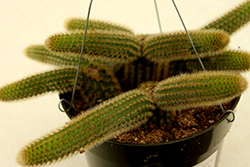Fri & Sat 8am - 8pm
Sun 8am - 7pm
Anytown, USA 12345
fax: 261.787.0463
e-mail: info@successgc.com


Plant Finder

Monkey Tail Cactus
Cleistocactus colademononis
Height: 12 inches
Spread: 8 feet
Sunlight:
![]()
Hardiness Zone: 9a
Other Names: Cleistocactus winteri subsp. colademono
Description:
An interesting native to Bolivia, this variety produces long, cylindrical stems covered in white-hairlike spines, reaching 8 ft. long; scarlet red flowers appear in the spring to fall; a fantastic specimen for indoor containers and hanging baskets
Ornamental Features
Monkey Tail Cactus is an atypical member of the cactus family known as an 'epiphyte' or 'air plant', which means that it doesn't necessarily require a growing medium for its roots. Like all other cacti, it doesn't actually have leaves, but rather modified succulent stems that comprise the bulk of the plant. This particular variety of cactus is valued for its characteristically trailing and weeping form on a plant consisting of long, narrow green segmented stems that form 'branches' which spread out from a central base.
Landscape Attributes
Monkey Tail Cactus is a small succulent evergreen plant with a form that trails along the ground or spills over containers and rock walls. It commonly grows as a shrub-like plant with multiple 'branches' and stems. As a type of cactus, it has no true foliage; the body of the plant is wholly comprised of a linked series of green narrow cylindrical segments which are connected together to form the branches of the plant.
This is a relatively low maintenance plant, and should not require much pruning, except when necessary, such as to remove dieback. Stray segments or shoots can be removed or thinned to control the overall form and spread of the plant. Gardeners should be aware of the following characteristic(s) that may warrant special consideration;
- Insects
- Spiny
Monkey Tail Cactus is recommended for the following landscape applications;
- Accent
- Rock/Alpine Gardens
- General Garden Use
- Container Planting
- Hanging Baskets
Planting & Growing
Monkey Tail Cactus will grow to be about 12 inches tall at maturity, with a spread of 8 feet. It grows at a slow rate, and under ideal conditions can be expected to live for approximately 10 years.
This plant should only be grown in full sunlight. Unlike most cacti, which are known for their strong preference for hot, dry growing environments, this plant is native to tropical climates and grows in areas with more humidity and rainfall than most cacti. It prefers dry to average moisture levels with very well-drained soil, and will often die in standing water. It is considered to be drought-tolerant, and thus makes an ideal choice for a low-water garden or xeriscape application. Like most succulents and cacti, this plant prefers to grow in poor soils and should therefore never be fertilized. It is not particular as to soil type, but has a definite preference for acidic soils. It is somewhat tolerant of urban pollution. This species is not originally from North America. It can be propagated by cuttings.
Monkey Tail Cactus is a fine choice for the garden, but it is also a good selection for planting in outdoor containers and hanging baskets. Because of its trailing habit of growth, it is ideally suited for use as a 'spiller' in the 'spiller-thriller-filler' container combination; plant it near the edges where it can spill gracefully over the pot. Note that when growing plants in outdoor containers and baskets, they may require more frequent waterings than they would in the yard or garden.
